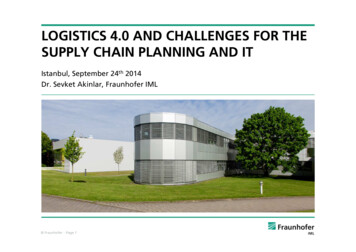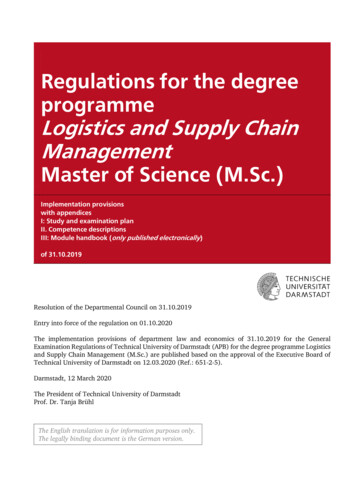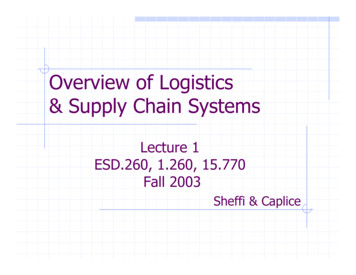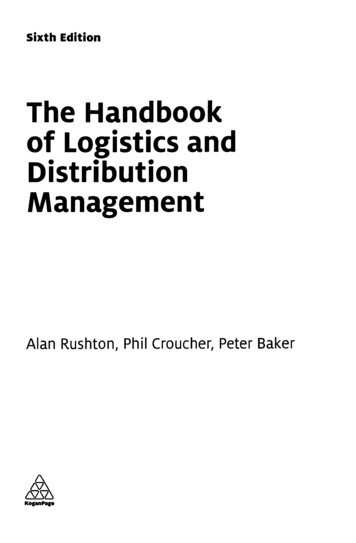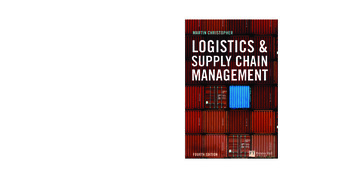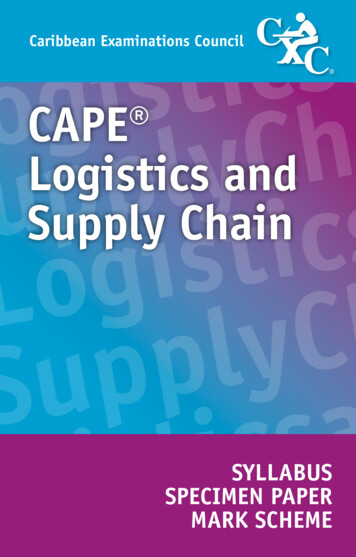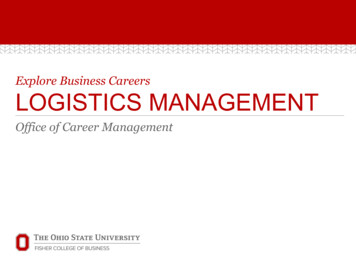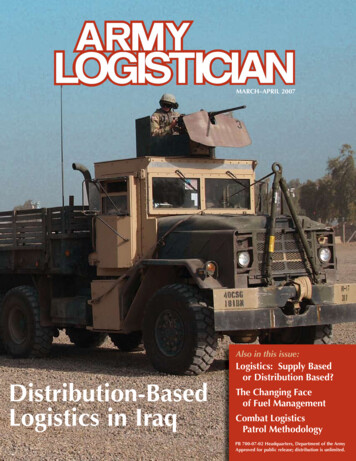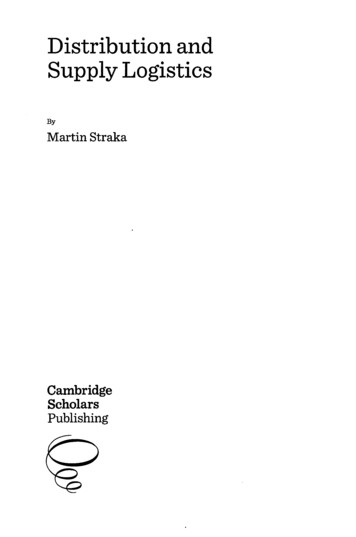
Transcription
Distribution andSupply LogisticsByMartin StrakaCambridgeScholarsPublishing
CONTENTSForewordxviiIntroductionxixI. The Methodological Basis of Distribution and Supply LogisticsChapter OneThe Position of Distribution and Supply Logistics in theLogistics System of a Company1.1 Logistics divisions1.2 Distribution and supply logistics1.2.1 Connections and relations between the conceptsof distribution and supply logistics1.3 Distribution, supply and its functions1.4 Distribution policy1.5 Further Clements of distribution logistics1.5.1 Distribution Channels1.5.2 Acquisition and logistics distribution subsystem1.6 Physical distribution and physical supply1.6.1 Storage1.6.2 Packaging1.6.3 Output ofgoods, loading1.6.4 TransportChapter TwoClassification of Items of the Distribution and Supply Space2.1 Definition of the items and criteria of the distribution space2.1.1 Items and criteria defining the shape and size of thedistribution and supply space2.1.2 Items and criteria influencing the topology of thedistribution and supply network2.1.2.1 Criteria defining the basic shape of the distributionand supply network2.1.2.2 Additional criteria that influenae the choiceof distribution stations2591319232323282930323435414142454648
viiiContents2.1.3 Items and criteria defining the Performance (Operation)of distribution and supply2.2 Classification of distribution and supply networks2.2.1 The basic types of distribution and supply networks2.2.2 Complex structures of distribution and supply networks2.2.3 Linkages between the items of distributionand supply networks2.2.4 Static anddynamic distribution networks495050535556Chapter Three58Rules of Distribution System Nodes3.1 Rules of keeping quantities of goods in distribution nodes583.2 Rules for creation of distribution groups and distribution circuits. 613.3 Rules for choosing a suitable method for locatinga distribution centre663.4 Rules for selection of type of distribution and supply network67II. Support Processes of Distribution and Supply LogisticsChapter Four72Designing Warehouses and Technical Facilities4.1 Warehousing as pari of logistics734.2 Storage Systems744.3 Types of storage and their functions744.4 Logistics Systems in storage784.5 Warehouse design814.6 The top requirements for building warehouses824.7 Aspects affecting storage projects844.7.1 Questions that influence warehouse design, "what?, when?,why?, how many?, where?, how?, how much money?, whatwith?,for whom?"854.7.2 Warehouse assortment904.7.3 Packages944.7.4 Means of transport954.7.5 Storage technologies984.7.5.1 Storage technologies for piece-goods984.7.5.2 Storage technologies for storage ofbulk material1024.7.6Handling tools in a warehouse1044.7.6.1 Handling equipment for piece-goodsin a warehouse104
Distribution and Suppiy Logistics4.7.6.2 Handling equipment for bulk materialin a warehouse4.7.7 The degree of warehouse mechanization4.8 The PDS model - project for distribution stock4.8.1 Characteristics of PDS model variables4.9 Calculation of warehouse capacityChapter FiveInformation and Communication Technologies in Distributionand Suppiy Logistics5.1 Information technology items5.2 Automatic identification Systems (AIS)5.2.1 Advantages of using AIS and its signißcance fordistribution logistics5.3 The importance of communication Standards for distributionlogistics - electronic data interchange EDI5.3.1 Advantages of communication Standards5.3.2 The use of communication Standards in distributionlogistics5.4 Management of distribution using satellite navigation5.4.1 GPS - Global Positioning System5.4.2 GLONASS - the Global Navigation Satellite System5.4.3 GALILEO - the European Satellite Navigation System5.4.4 The use of navigation Systems in distribution logistics5.5 The internet and its modifications5.6 Other Information technology applications in practice5.7 Overview of Information Systems in distribution logisticsChapter SixLogistics Costs and Actions in Distribution and Suppiy Logistics6.1 Costs6.1.1 Cost of circulation of goods6.1.2 The costs for distribution (the distribution costs)6.2 Views of physical distribution costs6.3 Costs of logistics6.4 Logistics actions6.5 Logistics indicators6.5.1 The key indicators of logistics 2145145145146147149151152153154155160164165166
XContentsIII. Methods, Models and Tools of Distribution and Supply LogisticsChapter Seven170Inventory Management7.1 Inventory optimization options1707.1.1 Inventory control strategies1727.1.1.1 Deterministic models of inventory management1757.1.1.1.1 The inventory management model witha deficit1827.1.1.2 Stochastic models of inventory management1917.1.1.2.1 The control of stochastic inventory consumption the fixed order quantity method1927.1.1.2.2 The control of stochastic inventory consumption fixed time period method201Chapter EightLocation as a Strategie Decision8.1 Location and multi-criteria decision making8.1.1 Definition of criteria8.1.2 Determination of weights for defined criteria8.1.2.1 Direct methods for determining criteria weights8.1.2.2 Indirect methods for determining the criteriaweights8.1.3 Calculation of the overall Utility ofparticular options8.1.4 Direct methods for assessing the overall Utilityof options8.1.5 Indirect methods assessing the overall Utility of options8.2 Location using mathematical-geometrical methods8.2.1 Location using the axial distance8.2.2 Location using quadratic distance8.2.3 Location using direct distance, Cooper's iterationmethod8.2.4 Location using the direct coordinated distance8.3 Expert Systems8.3.1 Expert Systems for solving distribution tasksChapter NineModelling Transport Tasks9.1 Formulation of transport tasks, type of relation m x n9.2 Methods suitable for solving transport tasks, type ofrelation m 74275280
Distribution and Supply Logistics9.2.1 The North West Corner method.9.2.2 The index method - Stepping stone9.2.3 Vogel's approximation method.9.2.4 The MOdified Distribution - MODI.9.3 Multi-level distribution networks, circular tasks, typeofrelation/ x m9.3.1 Method of distribution potential (MDP), multi-leveltype ofrelation 1 x m9.3.2 Circular tasks, Clarke-Wright's "saving" algorithm,one-level type of relation 1 * mChapter TenDimensioning Items in Distribution Networks10.1 Mathematical approach to defining the capacityof distribution warehouses10.1.1 Two-stage transport tasks, linkage type m x r * n10.1.2 X-stage transport tasks, linkage typem x y x » x . x z10.2 The use of Simulation for the purpose of defining thecapacity of distribution Clements10.2.1 Transactions, requirements - basic dynamic items10.2.2 The warehouse as a parallel queuing theory system,multichannel system10.2.3 A warehouse as a queue of un-serviced requests10.2.4 Solution of the transport task in the environmentof the EXTENDSIM Simulation system10.3 The heuristic approach to defining the capacityof distribution 3354355357370IV. Gase Studies and Applied Logistics Researchin Distribution and SupplyChapter ElevenApplied Research in Distribution and Supply Logistics and theSolution of Specific Tasks in Practice11.1 The procedure for solving distribution and supply problems374374
xiiContentsV. Case Studies from the Conceptual Design of Distribution SystemsChapter TwelveAnalysis and Proposal for Clothing Distribution within Alfa, Inc12.1 Definition of the problem and objective of the task12.2 Analysis of the present State of clothing distribution for Alfa,Inc. Puchov12.3 Planned development of Alfa, Inc. Puchov in domestic andforeign markets12.3.1 Building the retail network12.3.2 Wholesale distribution network12.4 Proposal for the retail distribution network of Alfa,Inc. Puchov12.5 Proposal for the wholesale distribution network of Alfa,Inc. Puchov12.6 Assessment of the results380Chapter ThirteenProposal for the Distribution System of a Brick Factoryof a Virtual Company in Kosice13.1 Definition of the problem and objective of the task13.2 Packaging, loading and transportation of products13.3 Analysis of brick sales13.4 Proposal for a suitable distribution system forBrick Factory Kosice13.4.1 One level distribution network— type "Star"13.4.2 Structured distribution network and definitionof distribution warehouses13.4.2.1 Dividing the distribution region by the"Method of Distribution Potential"13.4.2.2 Selection of distribution warehouses,distribution network13.4.2.3 Evaluation of results for truck transport13.5 Possibilities for using combined transport13.5.1 Length of the distribution track using railwaytransport13.6 Cost of distribution analysis13.7 Selection of the most suitable option, conclusionand assessment of 03405416424426426428429
Distribution and Supply LogisticsxiiiChapter Fourteen432Proposal for a Distribution Logistics and Transport System at Kapa,Inc.14.1 Definition of the problem and objective of the task43214.2 Characteristics of KAPA, Inc43214.3 The ränge of manufactured goods43314.4 Analysis of the distribution system at KAPA, Inc43314.5 Warehouses of KAPA, Inc43514.6 Customers of KAPA, Inc43514.7 Application of SWOT analysis for evaluation of thedistribution system at KAPA, Inc43614.8 Conceptual design for the establishment of a separatedistribution department44114.9 Proposal for activities of the distribution departmentfor KAPA, Inc44514.10 Proposal for creation of distribution plans for KAPA,Inc. in algorithmic form44714.10.1 Basic and supporting parts of the planning system44714.10.2 Description of basic planning system files44814.10.3 Basic algorithm for creating distribution plans45014.11 Summary of the defined Solutions for KAPA, Inc.product distribution system452VI. Case Studies in the Field of Location Problem SolvingChapter FifteenLocation of Warehouses for Gama, Inc. Secovce15.1 Definition of the problem and objective of the task15.2 Storage analysis in the Company15.3 Company transportation analysis15.4 Proposal for the location of the Company distribution centre15.5 Location without considering warehouse capacity in thedistribution system15.6 Location considering the capacities of warehouses in thedistribution system15.7 Location of a new place for production15.8 Assessment of results456456456457459461463465467
xivContentsChapter Sixteen468Proposing Locations for Operational Administration for the Needsof a Power Transmission System16.1 Definition of the problem and objective of the task46816.2 Characteristics of the PTS - analysis of the current State46816.3 Deficiencies resulting from the current Situation andpossibilities for Solution47116.4 Application of the method of distribution potential for theneeds ofPTS location47116.4.1 Selection and evaluation of criteria for multi-criteriaanalysis47216.4.2 Determination of the PS structure and theirsubordinate stations47516.5 Applying the geometric approach for the location of operationaladministration in the Power Transmission System48016.5.1 Calculation of the coordinates of the operationaladministration site48416.5.2 Analysis of the results obtained488VII. Case Studies from the Field of Distribution andCollection of Goods, Circular TasksChapter SeventeenApplication of Clarke-Wright's Saving Algorithm for Increasing theEfficiency of Distribution for Delta Warehouses, Inc. Presov17.1 Definition of the problem and objective of the task17.2 Characteristics of the Delta Warehouses, Inc. distributioncentre in Presov17.3 Presov DC distribution region17.4 Distribution of goods from the Presov DC17.5 Deficiencies determined by analysis of DC Deltawarehouses Presov17.6 Flanning distribution from Delta warehouses accordingto Clarke-Wright's algorithm17.7 Calculation of the savings matrix17.8 Requirements of shop units17.9 Flanning combined deliveries17.10 Determination of the Order for implementationof planned deliveries17.11 Summary of the procedura for the daily planningof goods deliveries
Distribution and Supply Logisticsxv17.12 Creationof a goods delivery plan with theuse of algorithms. 50817.13 Evaluation of optimization of goods distribution forDC Delta Warehouses, Inc. Presov51317.14 Conclusion and evaluation of the results515Chapter EighteenImproving the Efficiency of Goods Distribution and Collection ina Particular Region18.1 Definition of the problem and objective of the task18.2 Characteristics of the Metrological Centre18.3 Analysis of the current Situation and problems18.4 The possibilities for energy meter distribution18.4.1 Creation ofbuffer stores, multi-leveldistribution network18.4.2 Improving the efficiency of distribution circuitsand the length of their routes18.4.3 Other proposals for improving efficiency ofdistribution and collection18.5 Evaluation of results and conclusion of the task516516516518522522524527529VIII. Gase Studies from the Field of Inventory ManagementChapter NineteenDynamic Models of Supply and Management of Warehousesat Omega, Inc.19.1 Definition of the problem and objective of the task19.2 Characteristics of Omega, Inc19.3 The organizational structure of Omega, Inc19.4 Analysis of the procurement and supply System atOmega, Inc19.4.1 Strengths and weaknesses in purchasing inthe Company19.5 Analysis of the stock inventories of Omega, Inc.using the ABC and XYZ methods19.5.1 The application of ABC analysis in the specificbusiness environment19.5.2 Application ofXYZ analysis in the specificbusiness environment19.5.3 Combination of analysis methods ABC and XYZ19.6 Graphical assessment of incoming and outgoing materialsfrom the warehouse to production532532533533535539540541544546547
Contentsxvi19.7 Definition of deficiencies and proposals for more effectiveSolutions for purchasing activities at Omega, Inc55119.7.1 Possibilities for Solution of the personnel coverageof the TPPD position55319.7.2 Warehousesystem managementSolutions55319.7.3 Possibilities to address entering /not entering, verificationof delivery date andplanningfor means of transport55419.8 The proposal for the purchasing and logistics modelat Omega, Inc55519.8.1 Main algorithm of purchasing activities19.8.2 The dynamic model ofinventory management application with a fixed order quantity19.8.3 The dynamic model of inventory management application with a fixed time period19.8.4 Economic calculation19.9 Conclusion and summaryConclusionReferencesList of AbbreviationsList of FiguresList of TablesIndex
of distribution and supply logistics 13 1.3 Distribution, supply and its functions 19 1.4 Distribution policy 23 1.5 Further Clements of distribution logistics 23 1.5.1 Distribution Channels 23 1.5.2 Acquisition and logistics distribution subsystem 28 1.6 Physical distribution and physical supply 29 1.6.1 Storage 30 1.6.2 Packaging 32

